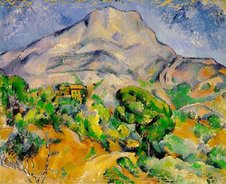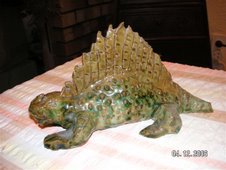Isn't she splendid ? Here's how she looked when we first laid eyes upon her in April 2002. No, not that startling piece of white ceramic kitsch in the foreground, at which even the dealer seems to be looking somewhat doubtfully. No, it's the antique galleon in the background that's the subject of this post. Here she is in close-up:
It was Antibes' annual Antiques Week, with the posher up-market stuff inside the pavilions erected along the Port Vauban. But the humbler brocante offerings spill over onto stalls lining the Boulevard d'Aguillon. That is Antibes' main tourist drag , with a string of Irish pubs and open-air restaurants.
The ship was well-nigh irresistible: the sails, despite being yellowed with age, look like real ones in miniature (see next picture), thanks to the weave, the stitching, and those stiffening fillets at the rear. They all combine to give an authentic scale-model effect, which you don't find on the modern made-in-SE Asia offerings.
And then there's the rigging, all painstakingly done, especially the rope ladders. I suspect the model was the handiwork of a real-life mariner, probably 19 th century, I would guess, done perhaps on his bunkbed on a long voyage. Every detail would have had to pass muster with critical fellow-crew members.
But as we handed over a wad of euros to the guy in the leather jacket, there was one factor that we had failed to take into account. Today, some 5 years down the line, it has become a matter for constant mulling over, especially with the arrival of each New Year.

And what might that be, you may ask ? Well, the picture below provides a clue.
Answer: cast your eye along the cotton bud to the end, which was dipped in liquid polish. The effect is to reveal that rich varnished timber lurking beneath many months accumulation of DUST !
But cleaning that tiny patch was just the beginning of the chore, starting with an easily-accessible part of the ship - the deck. Another 60 minutes of careful work would be needed to remove the rest of it, going into all those crevices, nooks and crannies, up and down the masts, along the spars, the bowsprits, pulleys, deck furniture. And then there's the thingumajigs , the wogglewidgets, and lots of other bits that probably all have proper names, of which I am profoundly ignorant, but am quite happy to make up if pressed to do so.
But how many times a year would you be willing, dear reader, to go through this routine ? Every month ? Every quarter ? If you are like me, you can probably think of more interesting ways to spend your time than meticulously dusting something so intricate and fragile, knowing that it's all got to be repeated later, over and over again.
Which is why, each January 1st, I look at that ship and ask myself : do I really want to continue with this performance ? And if so, at what intervals ?
Given that I don't have a personal Jeeves to attend to these chores, it comes down to three options:
1. Be extremely organized: set a date each month for cleaning the ship, so it never gets disgustingly dusty.
2. Carry on as usual. Only clean it spasmodically, as and when the spirit moves one, like when so much dust has settled as to give one instant gratification in seeing it before and after (as in the photo above).
In other words, clean it, at most, just once or twice a year: regard the cycle .... pristine....dusty..... disgustingly grimey...... back to pristine.... as the natural order of things, like the passing of the seasons . After all, we don't all rush out with a broom at the first sign of autumn and falling leaves. Or do we ? Oh dear, the Town Council sends people round to sweep them up. (And I've just recalled seeing ads in the paper for those overpriced gizmos that blow your fallen garden leaves into neat heaps . Does anyone actually buy those things, to sit in the shed unused for most of the year ?)
Or, if the truth be told, one could carry on as at present. Only do it under duress, like when one's expecting a visitor to the house - one where you want to create an instant impression of an immaculately maintained, well-ordered household ......... . Like the Queen, say, or a publisher .... So, on to the final option:
3. Consider that one has discharged a valuable public service, acting as trustee for an historical artefact. But take the view that perhaps the time has come to hand over one's stewardship duties to someone else. Another unsuspecting ... correction, another would-be guardian of our maritime heritage. In other words, take it back to the brocante, and see if one of the dealers will give me a good price for it. (Yeah, some hope!)
These are weighty issues indeed, ones needing an unclouded judgement for their resolution. No immediate decisions ought to be made so soon after all the festive celebrations, which went on last night till well after midnight, starting with those five over-rich courses at La Cascade in Antibes' Place Nationale .
There's plenty of time. In keeping with the planned change in tack for 2007 (flagged up in the preceding posts) I don't intend putting up anything new for at least another week.
So there's a few days in which to make the fateful decision on the future of my ship, as well as its present keeper - a New Year's resolution that serves as a kind of metaphor for the type of individual one intends to be in future. Yes, a defining moment has arrived in one's life. To be or not to be ? (organized, self-disciplined, that is, as distinct from a wastrel and layabout).
Here to conclude is a final picture of the ship, newly polished, handsome, magnificent. But has the time come to let it sail away ?

























































